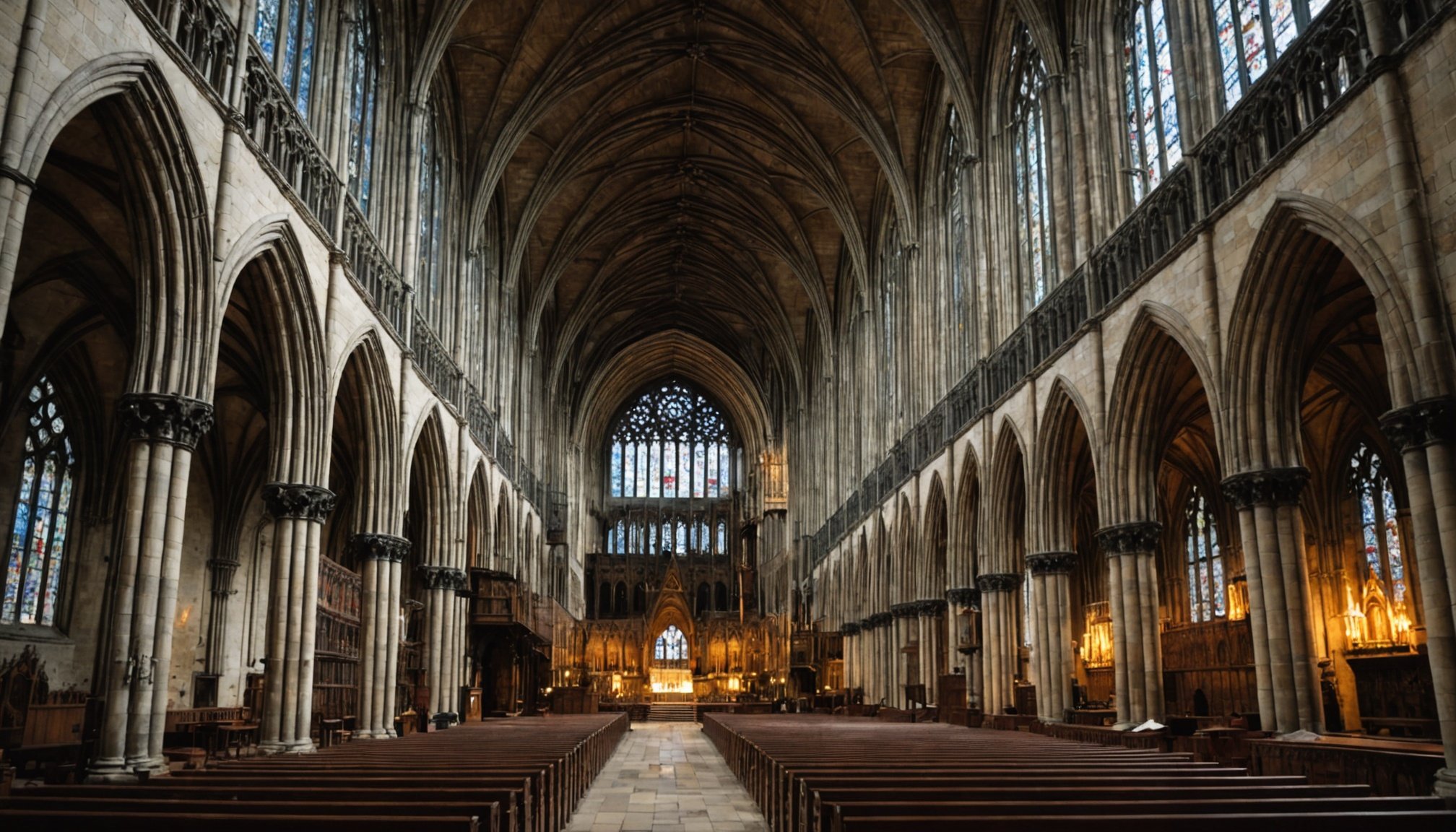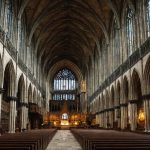Overview of Medieval UK Cathedrals
Medieval cathedrals are pivotal monuments reflecting the rich tapestry of UK history and their enduring architectural significance. These grand structures were not merely places of worship but also centres of community life, shaping local and broader societal norms. Each cathedral tells its own story, originating from a time when religion stood at the heart of town and city life.
Medieval cathedrals showcase a variety of architectural styles, primarily Romanesque and Gothic. The Romanesque style, characterised by robust and sturdy forms, features rounded arches and thick walls. As time progressed, the Gothic style emerged, notable for its pointed arches, flying buttresses, and slender vertical lines. These design elements allowed for taller structures and larger windows, which flooded the interiors with light.
This might interest you : Discover the Best Architectural Gems in the UK: Unforgettable Guided Tours
Beyond their architectural significance, cathedrals played a crucial role in religious and communal activities. They served as schools, hospitals, and even courts, highlighting their place as central hubs within medieval society. Each cathedral was a statement of both faith and community power, attracting pilgrims and tourists, fostering commerce, and contributing significantly to the economic prosperity of the area.
Notable Medieval Cathedrals in the UK
The United Kingdom is home to several historical landmarks that stand as testament to its rich medieval history. Each cathedral is not merely a matter of historical interest but also a key site for those exploring UK cathedrals directory.
Also read : Uncover the Premier UK Guided Tour Spots for Immersive British Aviation History Experiences
Canterbury Cathedral
Canterbury Cathedral is one of the most significant historical landmarks in the UK. As the seat of the Archbishop of Canterbury, it has been a pivotal religious centre. Its architectural evolution over the centuries reflects diverse styles, the most notable being Gothic.
York Minster
York Minster boasts stunning Gothic architecture and is renowned for its collection of medieval stained glass. This cathedral stands as a prominent landmark, offering visitors a glimpse into the city’s historical and architectural splendour.
Durham Cathedral
Durham Cathedral is a marvel of Romanesque architecture, with its massive stone columns and ribbed vaults. It is a designated UNESCO World Heritage Site, exemplary for its integral role in the history and development of Christianity in the UK.
These cathedrals, alongside many others, provide an avenue for exploring the historical richness of the UK’s medieval past.
Guided Tours of Medieval Cathedrals
Guided tours offer an immersive experience for those eager to explore the rich heritage of medieval cathedrals. These tours provide structured visits, combining historical insights with architectural marvels. Visitors can expect knowledgeable guides who illuminate the historical significance and unique stories of each cathedral. Tours often focus on the architectural styles, detailing distinctive features such as pointed arches and stained glass windows.
Facilitated throughout the week, these tours cater to diverse interests. Options range from general overviews to specialised tours for historians and enthusiasts, which delve deeper into specific historical contexts. For those keen on exploring UK cathedrals thoroughly, recommendations include participating in interactive sessions where visitors can engage with experts first-hand.
Incorporating a guided tour into your itinerary enhances understanding and offers a unique glimpse into the past. It’s advisable to check the availability and booking requirements in advance to ensure a seamless visit. For history buffs and architectural aficionados, these tours present an invaluable opportunity to appreciate the medieval brilliance that characterised the UK’s cathedrals.
Enhancing Experience with Visuals
Visual aids play a crucial role in enriching the understanding of _medieval cathedrals* by offering more than just scenic beauty. These aids bridge the gap between historical narratives and tangible reality, making history more relatable. For those keen on deeper _historical analysis*, visuals serve as a powerful tool to discern architectural details that mere words might miss.
Importance of Visual Aids in Historical Exploration
Understanding the role of _historian insights* becomes more accessible when paired with visuals. Diagrams and photographs highlight architectural transitions, such as the shift from Romanesque to Gothic styles, and provide insight into the cathedrals’ _historical significance*.
Recommended Resources for Maps and Photos
Visuals are not confined to static images. Interactive _maps* allow for virtual tours, offering a unique vantage point of the structure’s layout. High-quality photography captures intricate stonework and stained glass, pivotal in _cathedral design evolution*.
Curating a Visual Directory of Cathedrals
Creating a comprehensive visual directory supports _preservation* efforts by documenting the current condition of cathedrals. This archive aids in understanding the _key historical events* they witnessed, providing an invaluable resource for historians and novices alike.
Historical Insights from Historian Experts
Delving into the historical analysis of medieval UK cathedrals, historian insights shed light on the evolution of these monumental structures. Experts highlight the transition from Romanesque to Gothic architecture, a change spurred by advancements in engineering and aesthetics.
Interviews with Historians
Through interviews, historians provide valuable expert opinions on how these cathedrals were not just religious centres but also community hubs. Their construction techniques, use of materials, and symbolic elements are explored in depth, corresponding to the societal norms and powers of the time.
Articles and Research
Numerous articles and research papers focus on specific cathedrals. These works examine the architectural features and historical significance of each site, offering an insightful perspective for enthusiasts and scholars alike.
Historical Significance and Preservation
The preservation of medieval cathedrals remains paramount due to their historical importance. Efforts to maintain these sites ensure that they continue to narrate the rich tapestry of the UK’s past. Key projects and initiatives are ongoing, aiming to safeguard the cathedrals for future generations. Understanding their significance helps promote awareness and action towards their conservation.
Visitor Information and Planning Tips
When planning cathedral visits, considering the best times is crucial for a rewarding experience. Spring and autumn offer mild weather and fewer crowds. This allows visitors to enjoy the architecture and the surrounding areas comfortably. Seasonal considerations also include special events, which may enhance or restrict access.
Visitor tips include checking for accessibility options, especially for those with mobility concerns. Many cathedrals provide ramps and lifts to ensure all guests can explore fully. Services like guided audio tours can enrich your visit by providing historical insights at your own pace.
To maximise the educational experience, consider engaging with cathedral staff for unique stories and details often missed by general tours. Travel planning should account for opening hours and any mandatory booking requirements. This ensures seamless visits, preventing delays caused by unexpected closures.
Finally, remember to enjoy the spiritual ambience these spaces offer. They are not only historical landmarks but also places of quiet reflection and inspiration. With these considerations, visitors can fully appreciate the historical depth and beauty of the UK’s medieval cathedrals.










